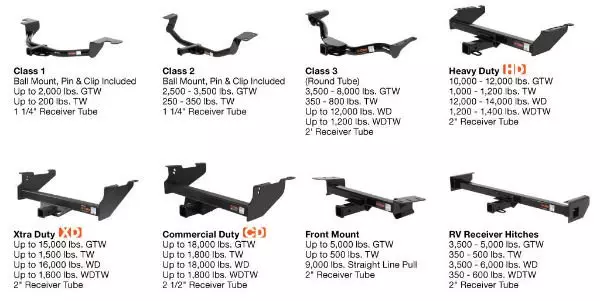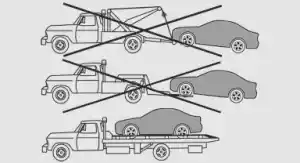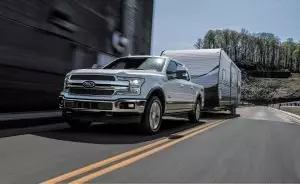If you’ve ever wondered about the distinction between Class 4 and Class 5 towing, you’re not alone. With so many options available, it’s essential to understand the differences to ensure you choose the right towing capacity for your needs. In this article, we’ll break down the dissimilarities between these two classes, shedding light on their specifications and helping you make an informed decision. Whether you’re a seasoned tower or a novice, this guide will provide you with the knowledge you need to navigate the world of towing successfully. So, let’s get started and discover what sets Class 4 and Class 5 towing apart!
Weight Capacity
Class 4 Towing Capacity
Class 4 towing refers to the ability of a vehicle to tow a certain weight. The weight capacity for Class 4 towing typically ranges from 7,000 to 10,000 pounds. This means that vehicles in this class have the ability to tow medium-sized trailers, such as small recreational vehicles (RVs), boats, and large utility trailers. With a Class 4 hitch and towing equipment, you can confidently tow these types of loads without exceeding the weight capacity of your vehicle.
Class 5 Towing Capacity
In comparison, Class 5 towing offers a higher weight capacity than Class 4. Depending on the specific vehicle, Class 5 towing can range from 10,000 to 30,000 pounds or more. This means that vehicles in this class are capable of towing larger and heavier loads, such as large RVs, horse trailers, heavy-duty construction equipment, and multiple utility trailers. The increased towing capacity of Class 5 makes it suitable for more demanding towing tasks that require the ability to haul substantial weights.
Vehicle Compatibility
Class 4 Vehicle Compatibility
Class 4 towing is compatible with a wide range of vehicles, including pickup trucks, SUVs, and some larger sedans. These vehicles often come equipped with the necessary structural features to support a Class 4 hitch, such as reinforced frames, heavy-duty suspension systems, and adequate braking capabilities. Additionally, Class 4-compatible vehicles may have specific towing packages or upgrades available to enhance their towing capacity and overall performance.
Class 5 Vehicle Compatibility
Class 5 towing is typically found in larger and more heavy-duty vehicles, such as full-size trucks, commercial vans, and some larger SUVs. These vehicles are specifically designed and engineered to handle the increased weight capacity of Class 5 towing. They often feature robust powertrain systems, reinforced frames, heavy-duty suspension, and advanced braking systems to ensure the vehicle can safely tow the load. Class 5-compatible vehicles are commonly used in commercial settings or for individuals with specialized towing needs.

This image is property of www.torklift.com.
Hitch Options
Class 4 Hitch Options
When it comes to Class 4 towing, there are various hitch options available to suit different towing needs. Class 4 hitches are typically classified as receiver hitches, which means they can accept a variety of hitch-mounted accessories, such as ball mounts or weight distribution systems. Class 4 hitches come in various sizes, including 1-1/4″, 2″, and 2-1/2″ receiver openings. It is important to select the appropriate hitch size and weight rating to ensure compatibility with your vehicle and towing capacity requirements.
Class 5 Hitch Options
Class 5 towing also offers a range of hitch options designed to handle the higher weight capacity. Class 5 hitches are generally larger and more robust than Class 4 hitches. They often feature 2″ or 2-1/2″ receiver openings, providing a sturdy attachment point for heavy-duty towing. Class 5 hitches may also offer additional features, such as reinforced construction, integrated towing accessories, or adjustable height options. These hitches are specifically designed to handle the demands of Class 5 towing and provide a secure and reliable towing connection.
Towing Equipment
Class 4 Towing Equipment
To properly tow with a Class 4 setup, you will need specific towing equipment designed to match the weight capacity and requirements of your vehicle and trailer. This may include items such as a Class 4 hitch receiver, ball mount, hitch ball, safety chains, wiring harness, and brake controller. It is crucial to choose towing equipment that is compatible with your vehicle and trailer to ensure safe and effective towing. Additionally, regular maintenance and inspections of the towing equipment are essential to ensure everything is in proper working order.
Class 5 Towing Equipment
For Class 5 towing, the required towing equipment is similar to Class 4 but may have higher weight ratings and additional features to accommodate the larger loads. Class 5 towing equipment includes a Class 5 hitch receiver with an appropriate weight rating, a heavy-duty ball mount, a hitch ball capable of handling the weight capacity, safety chains, wiring harness, and brake controller. It is critical to match the towing equipment to the specific requirements of your vehicle and trailer to ensure safe and efficient towing operations.

This image is property of dealer-cdn.com.
Structural Differences
Class 4 Structural Design
Vehicles in the Class 4 towing category generally have structural features that are designed to handle the weight capacity of this class. These features may include a reinforced frame, heavy-duty suspension components, and stronger axle assemblies. The additional structural support helps distribute the weight evenly and reduces the strain on certain components during towing. However, it is essential to check the manufacturer’s specifications for your specific vehicle to ensure it is capable of Class 4 towing.
Class 5 Structural Design
Class 5 towing vehicles are built with even more robust and heavy-duty structural designs. They typically have reinforced frames, heavy-duty suspension systems, stronger axle assemblies, and sometimes even commercial-grade components. The increased structural integrity allows Class 5 towing vehicles to handle the higher weight capacity without compromising safety and performance. Class 5 vehicles are commonly preferred for towing heavy loads and are often employed in commercial applications or specialized towing scenarios.
Powertrain Requirements
Class 4 Powertrain Requirements
To handle the weight capacity of Class 4 towing, vehicles in this class typically require a capable powertrain. This may include a powerful engine with sufficient horsepower and torque to tow medium-sized loads. Additionally, vehicles may have transmissions specifically designed for towing, such as heavy-duty automatic transmissions or manual transmissions with low gearing options. Adequate power and torque are crucial for maintaining control and stability while towing with a Class 4 setup.
Class 5 Powertrain Requirements
Class 5 towing vehicles demand even more substantial powertrain capabilities due to the higher weight capacity. These vehicles often feature powerful engines with high horsepower and torque ratings, specifically tailored for towing heavy loads. The transmissions in Class 5 vehicles are typically heavy-duty automatic transmissions or manual transmissions with advanced gear ratios to optimize towing performance. The robust powertrains ensure that Class 5 vehicles can handle the significant towing loads without strain.

This image is property of www.etrailer.com.
Safety Features
Class 4 Safety Features
Safety is always a crucial aspect when it comes to towing, regardless of the class. Vehicles in the Class 4 towing category often come equipped with various safety features to ensure safe towing experiences. Common safety features include advanced braking systems, such as electronic brake controllers or trailer brake systems, which help improve stopping power and control when towing. Other safety features may include stability control systems, trailer sway control, and heavy-duty cooling systems to prevent overheating during towing.
Class 5 Safety Features
Class 5 towing vehicles typically offer a wide range of advanced safety features due to the demanding nature of towing heavy loads. These vehicles often come equipped with enhanced braking systems, including heavy-duty disc brakes, high-performance brake pads, and larger brake rotors. Class 5 vehicles may also feature advanced stability control systems, integrated trailer brake systems, adjustable suspension systems, and additional cooling capabilities to handle the increased towing demands. The comprehensive safety features of Class 5 vehicles aim to provide a secure and controlled towing experience.
Price Range
Class 4 Price Range
The price range for vehicles capable of Class 4 towing can vary significantly depending on the make, model, and specifications. Generally, vehicles in the Class 4 towing category range from around $25,000 to $60,000 or more. The specific features, brand reputation, and additional options can greatly impact the price of a Class 4 vehicle. Additionally, the cost of additional towing equipment and accessories should be considered when budgeting for Class 4 towing.
Class 5 Price Range
Class 5 towing vehicles tend to be more expensive due to their larger size, heavier capabilities, and specialized designs. The price range for Class 5 vehicles can start from around $30,000 and go up to $100,000 or more, depending on the specific make and model. The higher price is justified by the increased towing capacity, advanced features, and additional safety components. It is important to research and compare different Class 5 options to find the best vehicle that meets your towing needs and budget.

This image is property of letstowthat.com.
Common Applications
Class 4 Common Applications
Class 4 towing is well-suited for a variety of common towing applications. This includes towing small to medium-sized recreational vehicles (RVs), such as travel trailers or pop-up campers. Class 4 towing is also suitable for hauling boats, horse trailers, small construction equipment trailers, and large utility trailers. Many outdoor enthusiasts and weekend warriors find Class 4 towing capabilities to be perfect for their recreational needs while still offering a reliable and capable towing experience.
Class 5 Common Applications
Class 5 towing is commonly used for towing heavier loads and is often employed in commercial applications. Class 5 vehicles are suitable for hauling larger recreational vehicles, such as large fifth-wheel trailers or motorhomes. Additionally, Class 5 towing is well-suited for towing heavier construction equipment, multiple utility trailers, large livestock trailers, and commercial cargo trailers. These vehicles are often utilized by contractors, large-scale landscapers, and individuals with specialized towing requirements.
Licensing Requirements
Class 4 Licensing Requirements
When it comes to licensing requirements for Class 4 towing, it is essential to consult the specific regulations and guidelines of your jurisdiction or country. In general, Class 4 towing may require a regular driver’s license, as long as it falls within the weight and size limits set by the licensing authority. However, if the towing combination exceeds certain parameters, such as maximum weight or length, a specialized license or endorsement may be required. It is crucial to familiarize yourself with the licensing requirements to ensure compliance and legal operation of your Class 4 towing setup.
Class 5 Licensing Requirements
Similarly, the licensing requirements for Class 5 towing are dependent on local regulations and guidelines. Class 5 towing often requires a specialized license or endorsement due to the higher weight capacity and specialized equipment involved. Commercial driver’s licenses (CDLs) are commonly required for individuals operating Class 5 towing setups for commercial purposes. It is crucial to check the local licensing requirements and obtain the appropriate license or endorsement before towing with a Class 5 setup to ensure compliance with the law and safe operation.

This image is property of www.hitchweb.com.



